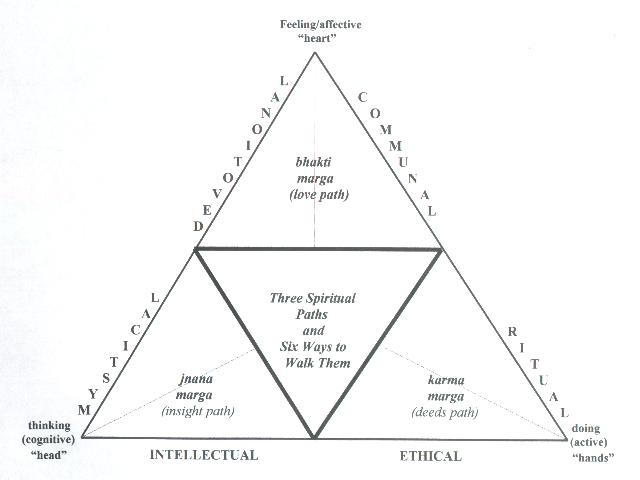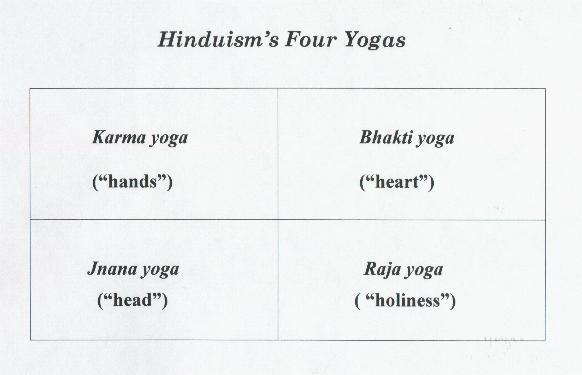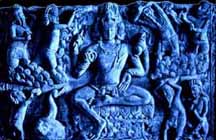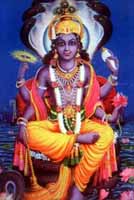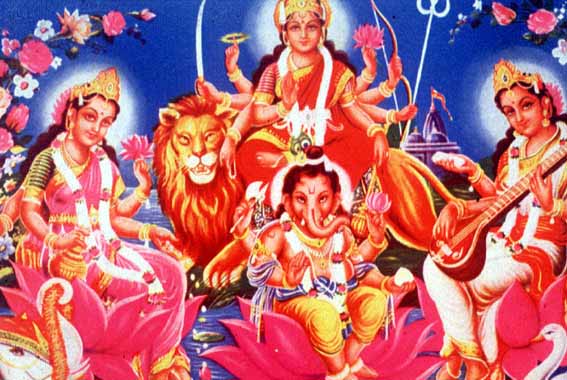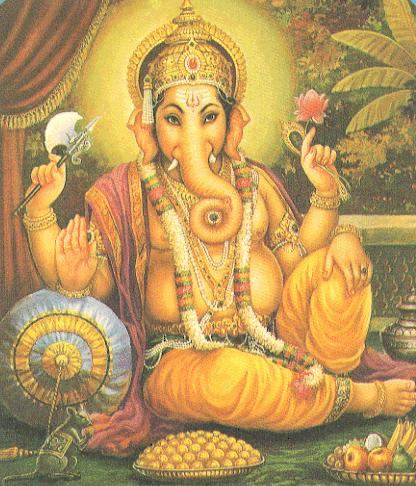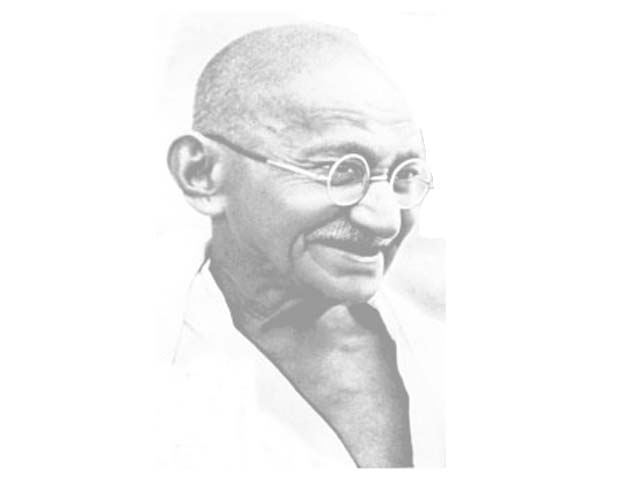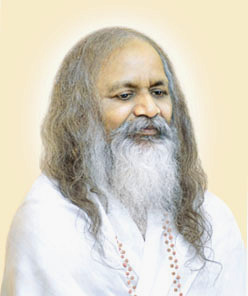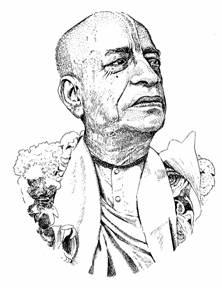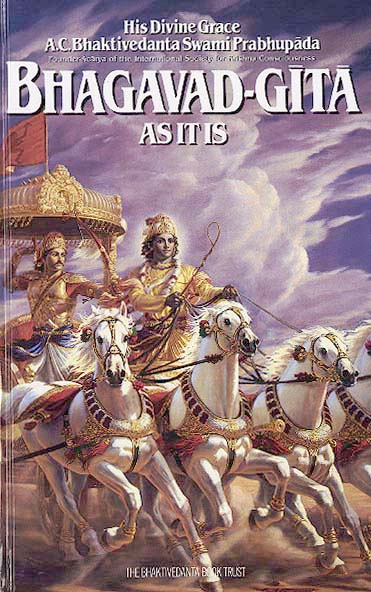1. Overview: Hinduism is one of oldest and most complex of the world'sreligions: roots are dated from 3rd millennium BCE (the 2000s!); "Hindu" and "India" come from the Sanskrit name for the Indus River (Sindhu); Hinduism = an ancient, wildly diverse, extremely inclusive, tolerant, complicated and "messy"; it recognizes three ways to be religious, and these provide one good way to sort the religion typologically and historically:
a. karma marga= "deed path" = "religion of the hands" (ritual and/or ethical): emphasis on Rite/Right- characterized early Vedic period (1500-600 BCE); focus: polytheism and ritualism; main scripture is the Vedas (ritualistic material, hymns)
b. jnana marga = "insight path" = "religion of the head" (intellectual and/or mystical): emph. on Wisdom/Truth- characterized Vedantic period (600 BCE-800 CE); focus: monism and mystical philosophy; main scripture is the Upanishads (philosophicalmaterial)
c. bhakti marga = "love path" = religion of the heart (devotional and/or communal): emph. on Faith/Love- characterized Sectarian period (800CE-present); focus: henotheism and worship (puja); main scripture is Bhagavad Gita ("Krishna is Lord!")
[Note #1: These margas are sometimes labeled as yogas, and numbered at four rather than three. That larger number is arrived at by isolating out the mystical side of jnana as a separate disciplinecalled raja yoga.][Preview: What we will see when we get to the history of Hinduism is that the whole religion has gone through three major phases, each corresponding to one of these three margas. Preview:
deed: karma marga - Vedic Period (1200-600 BCE)- polytheistic, ritualistic: Vedasknowledge: jnana marga - Vedantic Period (600 BCE-800 CE)-monistic, philosophical: Upanishadsdevotion: bhakti marga - Sectarian Period (900CE-now)
-henotheistic, devotional: Bhagavad Gita]
[Note #2: All three (or four) are found in all the world's religions,though particular schools, sects or denominations, and individualsgenerally emphasize one over the other two (or three). Familiar examples:
(1) Scientology and Unitarianism as religions of the "head";
(2) Protestant Revivalism (e.g., Billy Graham) and Krishna
Consciousness (Hare Krishna) as religions of the "heart";
(3) Roman Catholic sacramentalism, Puritan "work ethic," and
Native American ceremonialism as religions of the "hands";
(4) Hindu yoga and Buddhist zazen as religions of "holiness"/
"wholeness"]
2. Historya. Roots (Pre-Vedic India)
(1) Aryan invasion
(a) H. came to India when nomadic Aryan conquerors c. 1500 CE brought their polytheistic religion from Persia in second millennium and combined it with polytheistic Indus valley native Indian ancient culture religion;
[1] the Indus Valley people (called Harrapans or Dravidians) were dark-skinned, settled, peaceful, agrarian: their religion bore marks of fertility: feminine "mother earth" dynamic, more typical of Neolithic tribal religion;-their culture lasted from about 2150 to 1500 BCE
[2] Aryans were lighter-skinned (but not Caucasian), nomadic, shepherds, tribal, warlike, uncivilized; their Indo-European language became the basis of Sanskrit; their polytheistic religion was patriarchal and bore a masculine dynamic;-came in waves 1750-1200 BCE, and probably were pretty much in control after 1500 BCE
- Aryan society was stratified: (3 classes/castes that later became the top three castes of four)
(2) Aryan religion ("proto-Hinduism"?)
(a) polytheistic : gods/goddesses (devas) as personifications of natural forces; a male-dominated pantheon; according to tradition there are 330,000,000 of these gods and goddesses(b) sacrificial: movable altars in open places (vs. temples)
- animal sacrifices and libations of milk and soma (juice or hallucinogenic mushroom????)- horse sacrifice - only for rulers (too expensive for general use); horse set loose to roam one year, then caught and strangled (with the wives of the rajah participating infertility rites with its body); then carcass was ritually butchered and eaten by ruler and family; legend: any man who would perform 100 horse sacrifices would be master of the gods and the universe; (catch: only 1 per year was allowed!)
- last performed 8th c. CE
- many other animals
sacrificed (from bees to elephants)
b. The Vedic Era (1200-600 BCE)
(1) Definition: that earliest period of Hinduism; focuses on the most sacred of Hindu scripture: the Vedas (= a collection of hymns, rituals,chants, and a little philosophy); key religious/spiritual dynamics at this stage: polytheism and
ritualism (the gods and their relation to ritual, including sacrifices)(2) The Vedas: problem of dating, since are some pre-Aryan? (pre-2000 BCE) and some post-Aryan (1500-400 BC); early oral transmission makes dating difficult; there are four Vedas (written in Vedic, an ancient precursor of Sanskrit)
(a) Rig-Veda: m. imp.; collection of over 1000 hymns to the Aryan gods; mythology (c. 1200)
(b) Yajur-Veda: collection of ritual material for sacrifices
(c) Sama-Veda: collection of chants
(d) Atharva-Veda: home-rituals and popularprayers and spells to ward off evil;- each Veda has 4 parts, the first two being the oldest:
(a) Samhitas (hymns)
(b) Brahmanas (rituals)
(c) Aranyadas (mystical exercises materials: for retreats)]
(d) Upanishads (philosophical): 200 still extant
- became basis of all later Hindu philosophy; 14 are called "principle"; 9th - 6th centuries AD
- monistic vs. polytheistic
(3) The Gods -- the devas of the Vedas (acronyms); devas = the Vedic gods, each w/its place (loka), none was cosmic overlord; none was creator of universe; Rta (or Rita = the impersonal dynamicprinciple that keeps universe and society orderly -- what was later called Brahman
(a) Indra - has m. hymns to him in Vedas (250); god of the thunderbolt, clouds, rain; ruler of heaven (cf. Zeus, Jupiter); the conquerer of Vitra (evil personified);- often pictured as strong, lecherous, gluttonous, amoral warlord (cf. Zeus)
(b) Agni - god of fire (has 200 hymns); god of priests (re: sacrifices and fires), lightning, and sun; messenger of the gods: brings them prayers and sacrifices(c) Varuna - god of universal order (Rita) andkeeper of social order; v. moral himself and forgiver of sins
- did not create Rita, but only oversees it; all Gods are subject to it (both in its natural aspect or in its moral aspect);
(d) Rudra - god of death and destruction (later beame Shiva)(e) Yama - god of the dead; the first man to have died -- in Vedas, receives more attention then Rudra
(f) Vishnu - only briefly mentioned in Vedas; his importance is later in Hindu history
(4) Conclusion: The Vedic Era represents the practical dynamic of religion: karma marga (deed way/discipline); ritual is what is expected here:
c. Vedantic (Upanishadic) Era (6th c. BCE- 9th c. CE)
(1) Definition: the second, classic period of Hinduhistory, which sees a shift in focus:(a) fr/gods and sacrifice to Brahman and its relation to atman (one's inner spiritual energy-essence); and(b) from the Vedas as a whole to their philosophical sections, the Upanishads.
(2) The Upanishads: "Upanishad" means "a sitting beside," ("session") which implies a private, personal teaching from one's spiritual Master ("private lessons"); also called the Vedanta (= the "end of the Vedas"; 3 senses of "end": last part(s), last in importance, and goal; the first two senses prevailed in Vedic period, the third in the Vedantic period); the term Vedanta also refers to the tradition of Hindu
philosophy that focuses on these writings and makes the Upanishads the interpretative "lens" through which the Vedas and other scriptures are read; the Upanishads, then, are the speculative, philosophical portions of the Vedas; their main teachings as they were gradually articulated by the Vedantic philosophers:
(a) Brahman (a neuter noun that originally meant the power inherent in the words of Vedic prayers or spells) is the Ultimate Reality (not a god, but rather a Power, Presence, or Principle greater than any god in importance and potency); it is the Inner Spiritual Essence of the Universe and of everything in it;[1] Brahman has two aspects:
[a] Brahman Nirguna "without qualities"), utterly inaccessible to the mind and reason; this is the true Brahman (asMystery); and[b] Brahman Saguna ("with qualities," and especially sat [being], cit [consciousness], and ananda [bliss]; this is Brahman-as-manifest within the human realm, the cosmos, culture; in this aspect, Brahman has a personal side, called Ishvara, and can be thought and even called "he" and sometimes "God"; but this is not Brahman at its depths, but only the playful surface of the great "Sea of all souls" that is relatively accessible to human reason and discourse)
[2] Because of its unique nature and status, the best way to talk about Brahman is:[a] Silence, which is to say, not at all;[b] in terms of neti neti ("not this, not
that" or "neither-nor" approach best expressed in English as "in-" and "un-" words), a via negativa (Latin for "negative way") of arriving at the true nature of all reality; and[c] OM or AUM, the most important mantra (sacredsyllable or sound), capturing the whole reality of Brahman ("A" = eternal truth; "U" = esoteric knowledge; "M" = happiness in inner equilibrium)
(b) atman (another neuter noun) is the individual spiritual energy- essence within everything; it is[1] uncreated and eternal;
[2] recyclable; and
[3] none other than Brahman Itself (a drop in the Great Infinite Spiritual Sea, which is the Infinite Sum of its infinite drops); note that, as the true inner spiritual essence of a human being, atman (like Brahman, which is really is) is non-personal- because atman is Brahman, anyone has the right to declare aham brahmasmi = "I am Brahman!" (which amounts to "I am God!" -- and therefore a heresy! --
for a Westerner);- also, because a nickname for Brahman is Tat ("That" or "That One"), another famous teaching of Vedantic Hinduism is tat tvam asi = "That thou art"/"That's you!" which again means that you are the Supreme One, because of the fundamental identity of the self (atman) and (as!) Ultimate Reality (Brahman)
(c) samsara has two different but related meanings:[1] the everyday world (or "phenomenal reality"), which is: maya or "illusory," not absolutely, but as to its substantiality and importance; and lila or "frivolity" because of its superficiality (compared to the fathomless depths of the True Reality that is Brahman); the plane of human existence, therefore, is unstable, transitory, insubstantial, and finally insignificant;[2] the endless cycles of birth-life-death-rebirth; "reincarnation" or, more precisely, "transmigration of souls; they are perpetuated by avidya, which is "ignorance," namely of one's true nature as atman (it's the delusion that theself is a separate, individual entity and hence, confusion about the true nature of reality -- taking one'spersonal identity or "ego-self" as real), and by karma:
(d) karma has three related meanings:[1] "deed" or "action";
[2] the inevitable effects or consequences of the deed on its doer; and
[3] the dynamic interconnectedness of everything, the "law" balances out deeds and consequences, often entails (requires!) rebirth for justice to be realized; thus karma has brought us to our current, and can help to overcome that status for future existences; karma can be good or bad
(e) dharma means both[1] individual duty, virtue, righteousness and
[2] the cosmic order and harmony itself; as duty, it has the caste system as its backdrop and frame of reference
(f) moksha means "release," "liberation," "emancipation," and "enlightenment" that come with the realization of one's oneness with The One; it comes truly only at death, but is experienced in life (by jivan mukti or mahatma) as samadhi, a trancelike state in which an individual achieves an experience of absorption while still living
(3) Other Important Scriptures of this Period[Note: These fall under the category of smriti, or "traditional scriptures," which are the product of oral traditions; as opposed to the shruti, or "revealed scriptures" that came directly from the gods through rishis, or "seers"]
(a) Code/Law of Manu (c. 100 b.c.e) (Manu, according to the Vedas, was the only survivor of a great flood; was saved by a fish (= Vishnu in disguise (Noah and Jonah?) = an ethical writing; gives much information about life in this period,
especially social and religious rules/traditions:[1] caste system (varna = color = caste);each
caste has thousands of jati or subcastes as
well
[a] Brahmin - priests, scholars
[b] Kshatriya - warrior, rulers
[c] Vaishya - merchants, craftspeople
[d] Shudra - peasants, commoners
- each has its duties (dharma)
- only social mobility is through
reincarnation;
[e] Pariahs -- outcastes, untouchables][2] 4 life goals
[a] kama - pleasure
[b] artha - gain
[c] dharma - duty, righteousness
[d] moksha - liberation
- all are good, but only the last is ultimate[3] 4 life stages -- ashramas (rough correlation
to the 4 goals); only apply to the upper 3
castes, Shudras merely serve
[a] student (of Vedas)
[b] householder (married to woman 1/3
own age and of own caste)
[c] hermit (in old age: to forest retreat)
[d] wandering beggar (sannyasi)(b) Sutras (sutra = "thread," lesson), instruction
in outline form; especially important are:[1] Yoga Sutras (c. 100 BCE) = instructionin
hatha yoga (= phys. yoga; posturesand
breathing); hatha yoga is the preparation for
rajah yoga, the "royal yoga" of
contemplation whose goal is samadhi = the
highest state of meditation (virtual
moksha?),imageless trance, pure
concentration;
- Note that yoga connotes any spiritual
discipline that affords a "yoke" (yoga) to
connect Brahman and atman[2] Kama Sutra by Vatsyayana, 1-4th c.c.e;
= "Love Text" (a sex manual, but scripture
nonetheless)
d. Sectarian Hinduism - (c. 900 C.E./A.D. to present, Hopfe's "Post-Classical Period")(1) Def. --the last period of Hindu history, in which emphasis shifts to the religious dynamic of henotheism and devotion; belief in many gods continues, but interest focuses on a few major deities, and worship (puja) centers on them (amounting to love and devotion to gods and goddesses): we get here practical monotheism couched in a theoretical polytheism;(2) Key Scripture: The Bhagavad Gita = part of longer poem, The Mahabharata (= the story of a feud between 2 families since beginning of India, composed sometime between the 2nd century BCE and the 3rd CE ); the Gita is chapters 25-42 of Mahabharata (100,000 stanzas, the world's longest poem); the Bhagavad Gita is set on battlefield of the greatest battle between them (850-650 BC); centers on the conversation between the warrior Arjuna and his charioteer (= Krishna, who is really Vishnu in disguise); Arjuna is upset that he has to fight and kill his old teachers and kinsmen; Krishna reminds him of his dharma (duty) to go through with this task and of the eternality of the atman in himself and his enemies; (Krishna's teachings here are very much those of Upanishads (dharma,samsara,atman);
- what is new here is the suggestion, made by Krishna, that devotion (bhakti) to a caring god like him -- who comes to earth from time to time in the form of avatars or "incarnations" -- can lead to moksha;
- many see the BhagavadGita as marking the shift in Hindu religiosity toward Sectarian henotheism, in which a particular god or goddess or manifestation thereof becomes one's ishtadeva (personal deity) and the object ofone's devotion (bhakti) and worship (puja)
(3) The maingods: The first three are called the Trimurti ("ThreeForms"): Brahma, Vishnu, and Shiva
Separately, they are:
(a) Brahma, the Creator, the least popular of "big 3": has only 2 or 3temples dedicated to him in India, and no real following; but his 4-faced statue is in almost every shrine to Vishnu or Shiva; his consort or mate is Saraswati, patron goddess of school children;* * * * * * * * * ** * * * * * * * * * * * * * * *
(b) Vishnu,the Preserver (followers are called Vaishnivas or "Vaishnivites"); god of love, benevolence, forgiveness (especially concerned for humankind); has appeared on earth 9 times as avatars: one of these as the blue-skinned man-god Krishna; another as Rama; he has also come as a fish (e.g., in the Manu flood story mentioned above); and will come a 10th time to end this age as the horse-headed Kalki;
* * * * * * * * * ** * * * * * * * * * * * * * * *
(b) Shivaor (Siva, but still pronounced with the "h"), the destroyer (followers are called Shaivas or "Shaivites"); he is by far the most popular of the deities; he is the god of death, disease and destruction; dance and music; sexuality and reproduction (in mythology and sculpture he is depicted as ithyphallic, i.e., having a constantly erect penis, and sometimes as having female sexual organs as well and/or as a hermaphrodite (left side is female; right side is masculine); despite his "job description, not a negative god
at all; he merely destroys that which is old and used up to make way for the new; death also makes reincarnation and thus spiritual advancement possible; his symbols: trident, drum, snake, and linga (penis); his female consorts are Parvati, Durga, and Kali (the latter two being rather terrifying in appearance because they are fearsome opposers/devourers of evil)* * * * * * * * * ** * * * * * * * * * * * * * * *
(d) Shakti refers both to the power of Brahman, which is seen as feminine, and to the various female consorts of the male gods; pictures above, left to right, are Lakshmi, consort of Vishnu; Durga, consort of Shiva, and Sarawati, consort of Brahma; seated in front of Durga is:
(e) Ganesha (Shiva's elephant-headed son) is a very popular god among Hindus of all sects; he is the god of good luck, prosperity and wisdom; remover of obstacles; patron god of business people
e. Tantrism- an "odd" form of Hinduism that doesn't quite fit in any category; it uses ritual-magical techniques to achieve liberation; mantras formulas, mandalas (diagrams), sex, yogic techniques (to release kundalini, a snake-like power coiled at base of spine), and to manipulate 6 chakras, lotus centers of psychic energy; Tantrism is sometimes equated with Shaktismf. Modern Hinduism--Three Famous Representatives Who Have Impacted the West ("Universalizers")
1. MohandasKarachand Gandhi (1869-1948), aka "Mahatma" = great souled one;(a) his life: a lawyer of Vaishya class; spent many years in S.Africa promoting nonviolent movement for Indians' rights there; returned to India and in 1920 became leader of India National Congress (which led to overthrow of British rule in 1947); the following year, he was assassinated by a fanatical Hindu nationalist (ag/British, Muslims, and other foreign influence in India), for whom Gandhi was too open and accepting(b) his religion: not learned in Hindu scripture; not a systematic or original religious thinker; not a theoretician or speculative; not even a mystic; was very eclectic: was fan of BhagavadGita, the
Sermon on the Mount of Jesus, Thoreau; had two dominant religious principles [1] "God is Truth,"so"all religions are true, but each is truest in its own land"; and (2) satyagraha (literally, "holding on to the truth") or appealing to the conscience of the opponent non-violently; his religious emphasis or path, then, was a cariety of "hands-on" karmamargatype, of the social-political ethics variety; his thinking and example were a huge influence on Martin Luther King, Jr. in the 1960s
2. MaharishiMahesh Yogi (1911- )
(a) His life: the guru of the Beatles in the mid-to-late 1960s, and founder of the Spiritual Regeneration Movement or TM (TranscendentalMeditation); also founder of Maharishi University in Fairfield, Iowa(b) His religion: meditation, and therefore the jnana marga type
3. A. C. Bhaktivedanta, Swami Prabhupada (d. 1977)
a. His life: greatest and most influential modern interpreterof the Bhagavad Gita, and founder of the International Society for Krishna Consciousness (ISKCON) = the Hare Krishna Movement; author of The Bhagavad Gita As It Is:
3. SummaryHinduism has endured challenges from reform movements within India (Vedanta, Jainism, Buddhism,and Sikhism) and from other exogenous religions (Islam, 15th c. and Christianity, 16th - 19th c.); and has always managed to tolerate and adjust and maintain the hearts and minds of most of the people of India; most serious tensions: with Muslims and Sikhs; one reason for its durability: it is so complex, there's "something for everyone" -- millions of gods, many ways to "salvation," etc. ("One can find within Hinduism almost any form or style of religion that has been conceived or practiced by mankind. " - Lewis Hopfe); Hinduism also has an enormous capacity for tolerance of vastly different beliefs and practices

